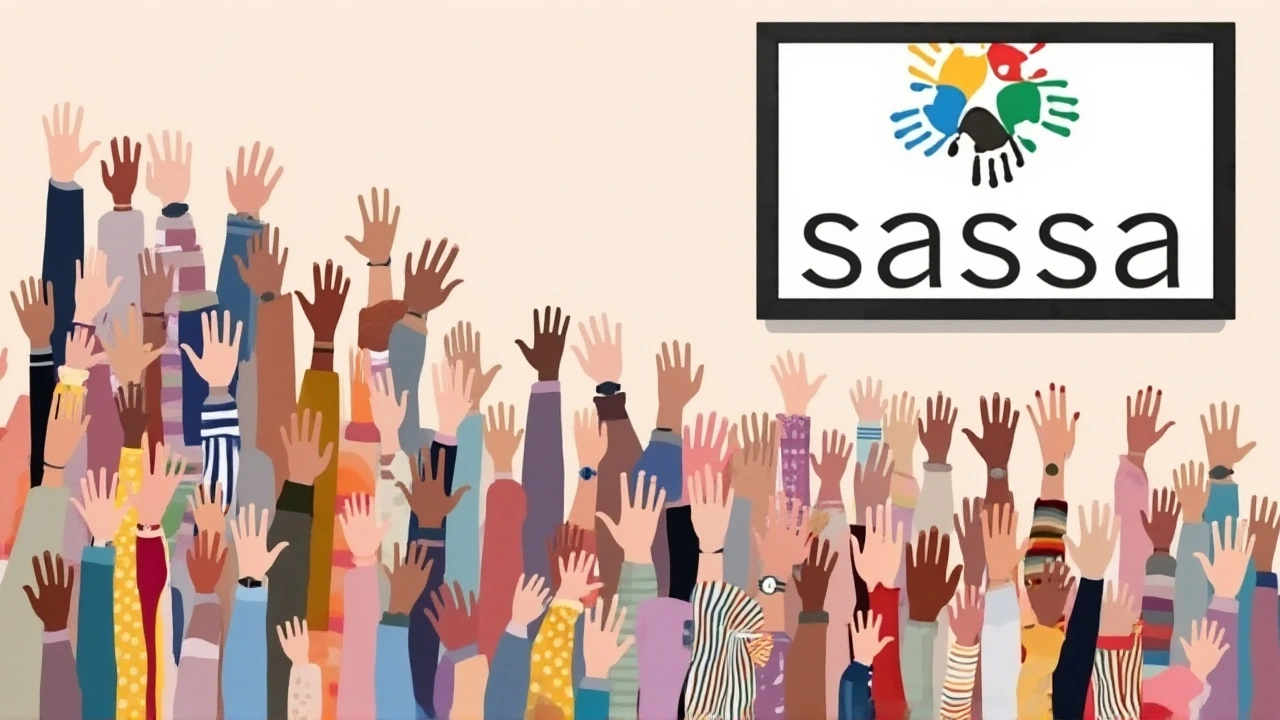When SASSA announced the September 2025 grant payment timetable, Minister Lindiwe Zulu, Minister of Social Development of South Africa emphasized the need for staggered withdrawals to ease ATM queues. The agency said beneficiaries could expect three consecutive payment days, starting on Tuesday, 2 September 2025.
Why a three‑day roll‑out?
The staggered approach isn’t new, but it has become a cornerstone of SASSA’s logistics playbook. By allocating specific grant categories to individual days, the agency smooths out a cash flow that totals roughly R70 billion each month. Old age pensioners – about 5.6 million people – get first dibs, followed by roughly 1.2 million disability recipients, and finally the roughly 9 million child‑grant families and other smaller programmes.
“Our priority is to get money into the hands of those who need it most, without turning the nation’s ATMs into a battlefield,” said Thabo Mokoena, spokesperson for SASSA.
September 2025 payment calendar
- Tuesday, 2 September – Old Age Grant
- Wednesday, 3 September – Disability Grant
- Thursday, 4 September – Child Grant and all other categories
Separate from the main schedule, the COVID‑19 Social Relief of Distress (SRD) grant will be disbursed on Friday, 5 September 2025. The SRD fund, introduced in 2020, still supports roughly 800 000 households still feeling the pandemic’s economic aftershocks.
Encouraging card‑based payments
SASSA is nudging recipients toward its prepaid SASSA Card, which works like a Debit Mastercard at any retailer that accepts chip‑and‑pin. The card can be loaded directly with the grant amount, letting users pay for groceries, transport or school fees without ever handling cash.
Data from the agency’s 2024 pilot shows a 27 % drop in ATM‑related complaints when card usage spikes. “It’s not just about convenience – it’s about safety,” Mokoena added. “Criminals target people who walk away with a stack of notes. The card eliminates that risk.”

What beneficiaries need to do
First, check that banking details are up‑to‑date. Around 12 % of electronic‑transfer recipients reported failed payments in the last quarter because of outdated account numbers.
Second, plan withdrawals. SASSA advises people to take only what they need for the week, then replenish as necessary. “If you pull the full amount on day one, you’ll find the nearest ATM out of cash by midday,” warned Zulu during a press briefing at the Department of Social Development in Pretoria.
Broader implications for South Africa’s cash economy
The staggered schedule does more than keep queues short; it cushions the banking sector from sudden, massive inflows that can strain liquidity. The South African Reserve Bank (SARB) tracks daily cash‑in‑flow spikes and reported that the three‑day spread reduces peak demand by nearly 40 % compared with a single‑day payout.
Economists also note that smoother cash flow supports informal sellers who rely on daily transactions. When beneficiaries withdraw gradually, demand for small‑scale goods remains steady throughout the month rather than peaking sharply in the first week.
Looking ahead: potential tweaks and challenges
While the system works, SASSA faces pressure to digitise further. A 2023 parliamentary committee recommended linking grant payments to mobile‑money platforms, a move that could reach the estimated 3 million unbanked citizens.
However, rollout hurdles remain – internet connectivity gaps in rural KwaZulu‑Natal and the Eastern Cape, and concerns over data privacy. The agency says a pilot with telecom partner MTN will launch in early 2026, testing direct‑to‑phone payouts for a subset of child‑grant families.
For now, the September 2025 timetable will serve as the benchmark. If the three‑day model stays on schedule and ATM congestion stays low, SASSA may cement the approach as the permanent standard, rather than a temporary fix.

Frequently Asked Questions
How does the staggered schedule affect elderly recipients?
Elderly pensioners receive their money on the first day – Tuesday, 2 September – giving them priority access before cash queues build up. The early payout also allows them to plan purchases for the month without competing with other grant categories for ATM time.
What should beneficiaries do if their bank details have changed?
They must update their information via the nearest SASSA office, the online portal, or by calling the dedicated helpline (0800 770 770). Failure to do so can result in delayed electronic transfers, as seen with roughly 150 000 accounts last year.
Why is SASSA promoting the use of the SASSA Card?
The card lets recipients pay directly at participating retailers, cutting down on cash handling and reducing theft risk. It also eases pressure on ATMs, which often run out of cash on busy payment days.
What are the payment dates for the COVID‑19 SRD grant?
The SRD grant for September 2025 is slated for Friday, 5 September 2025. Recipients will receive a one‑off top‑up of R1 800, subject to eligibility verification.
Will future grant cycles continue using a three‑day rollout?
SASSA plans to keep the staggered system unless data shows a clear benefit from a different model. Ongoing pilots with mobile‑money providers could eventually add a fourth day for digital‑only payouts.


Shubham Abhang
Wow, the three‑day rollout sounds like a genius move, but I can’t help noticing the sheer amount of paperwork they keep pushing onto the elderly, frae fra! If the ATMs are jammed again, we’re all stuck waiting in line, and that’s just not acceptable.
Trupti Jain
The staggered schedule, while well‑intentioned, may inadvertently prolong financial strain for some households.
deepika balodi
It’s good that SASSA is encouraging the card, but the rural connectivity gaps could still hinder many beneficiaries.
Priya Patil
These staggered dates should really help keep the lines moving, and the card adoption will make daily purchases smoother. Remember to double‑check your banking details ahead of time, and plan only what you need for the week. A little foresight now can save a lot of hassle later.
Maneesh Rajput Thakur
First, let me point out that the three‑day rollout is not a random convenience, it’s a calculated maneuver orchestrated by the global finance elite to keep cash flow under their control. By segmenting the grants, they can monitor spending patterns and feed data into larger surveillance networks. The old‑age pensionists get priority, sure, but that’s simply a façade to disguise the real agenda. Second, the push for the SASSA Card is a thinly veiled attempt to push the unbanked into digital ecosystems controlled by a handful of multinational banks. Every swipe on that card creates a digital trail that can be sold to third‑party advertisers. Third, the timing of the COVID‑19 SRD disbursement on a separate Friday ensures a last‑minute influx of cash that can be funneled into politically connected enterprises. The Reserve Bank’s claim that staggered payments reduce liquidity spikes is a myth; they simply want to keep the banking sector dependent on their policy decisions. Moreover, the pilot with telecoms in 2026 hints at a future where mobile money becomes the only legal tender, effectively eliminating cash. This would make it easier for the government to impose price controls and tax every transaction. Rural areas will suffer the most, as the required internet infrastructure is nowhere near ready, leaving millions vulnerable to exclusion. The emphasis on updating banking details is a double‑edged sword, offering a pretext for identity theft and data harvesting. In addition, the reliance on chip‑and‑pin technology excludes the elderly who are not tech‑savvy, forcing them into a dangerous reliance on younger family members. The whole system is a perfect storm of control, surveillance, and economic manipulation. If citizens do not question the motives behind these “efficiencies,” we will end up surrendering much more than just our cash. Finally, the only way to truly protect vulnerable populations is to demand transparent, community‑driven alternatives that keep cash in the hands of the people, not in the hands of shadowy financial actors.
ONE AGRI
Honestly, reading that rant makes my blood boil; how can anyone think that protecting our seniors is a conspiracy? Our leaders are doing their best to keep the lines short and the cash flowing safely, and that’s something we should all be proud of as South Africans. The mention of “global finance elite” feels like a tired cliché that distracts from the real issue: getting food on the table. While we should stay vigilant, we must also recognize the hard work of the SASSA staff, who are often underappreciated and overworked. The push for the card is about modernising our economy, not about some nefarious plot. Let’s focus on the positives: fewer robberies at ATMs and a smoother experience for everyone. In the end, it’s about community resilience and protecting our families.
Himanshu Sanduja
Nice move by SASSA the staggered dates should keep the queues short and the stress low. Just make sure you have the right bank details before the day comes.
Kiran Singh
Exactly! 😃 Planning ahead really helps and the card makes everything easier.
Balaji Srinivasan
I appreciate the effort to reduce ATM crowding, but I worry about those without reliable internet access.
Hariprasath P
Yo bro, the whole net thing is a mess in the villages, they cant even get a signal, so any digital rollout is kinda sucks lol.
Vibhor Jain
Great, another bureaucratic schedule that promises efficiency while adding another layer of paperwork.
Rashi Nirmaan
While the intent of staggered disbursement may be commendable it nonetheless introduces procedural complexities that could undermine the very objective of expedient aid distribution.
Ashutosh Kumar Gupta
Oh, the drama! Yet another “solution” that sounds brilliant on paper but leaves the most vulnerable scrambling behind the scenes.